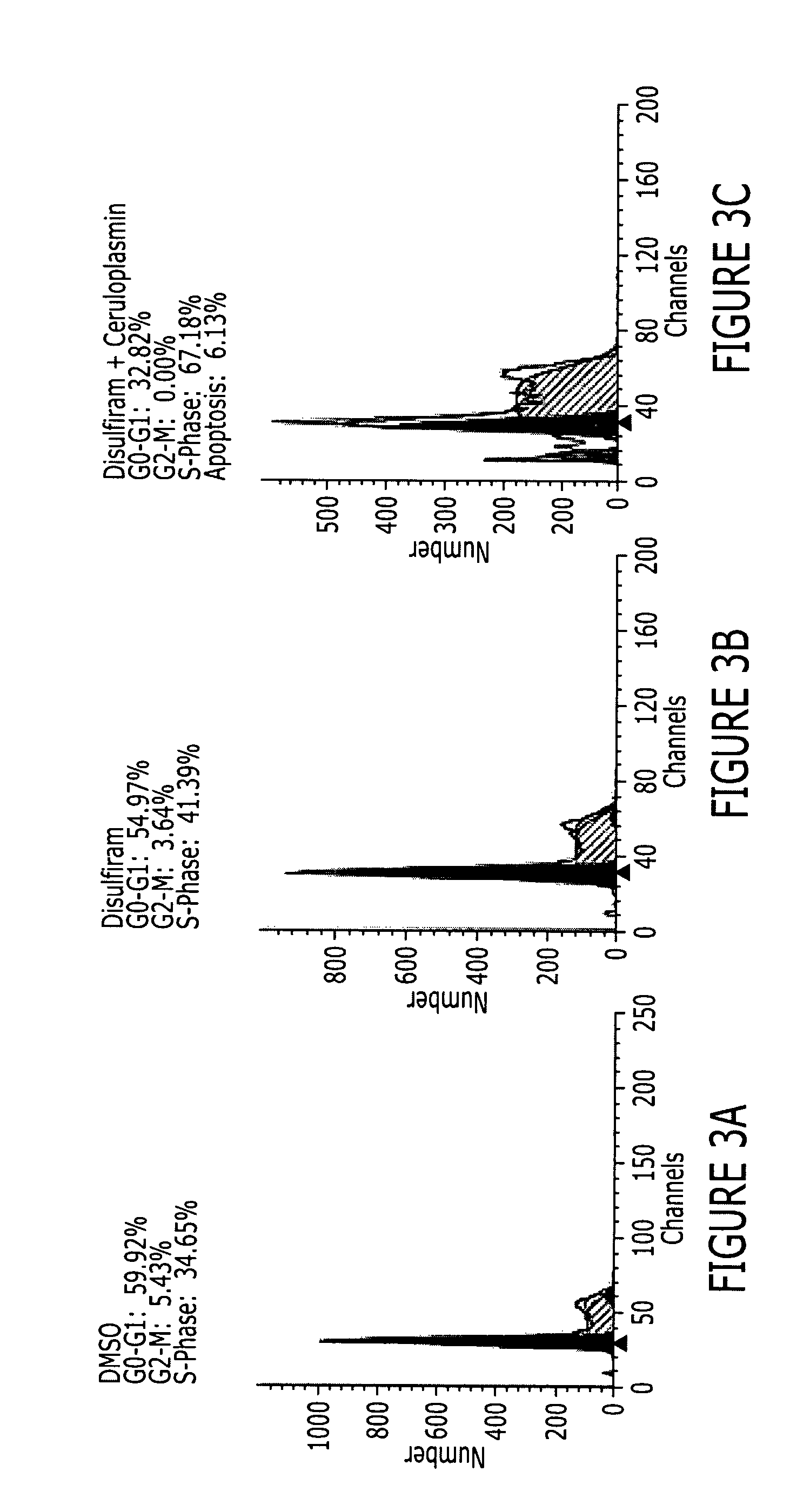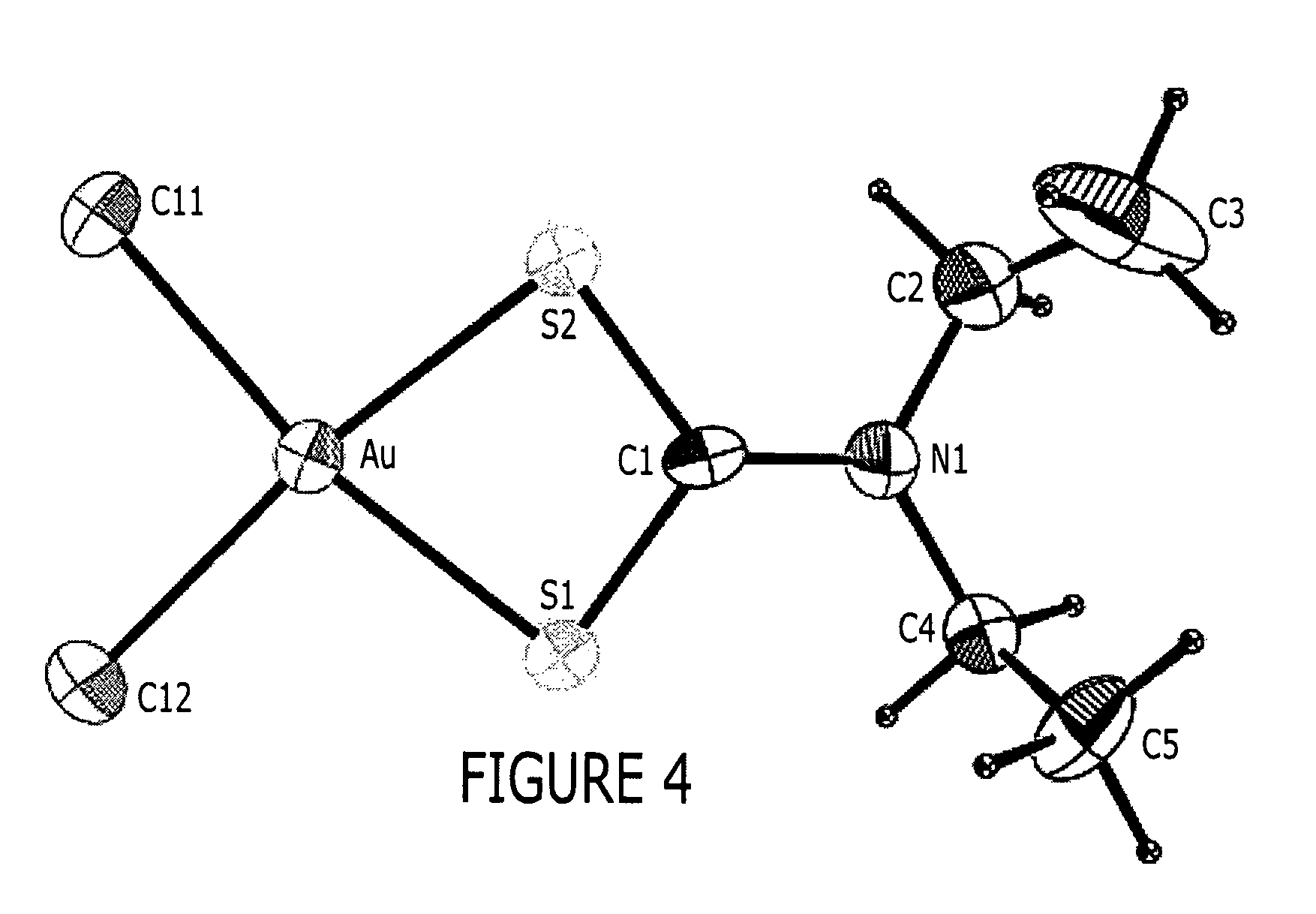Method of inhibiting ATF/CREB and cancer cell growth and pharmaceutical compositions for same
a technology of atf/creb and cancer cells, which is applied in the direction of biocide, drug composition, peptide/protein ingredients, etc., can solve the problems of uncontrolled growth of malignant cells, poor response to chemotherapy of other cancers, and death of patients, so as to inhibit the tumor cell growth inhibition effect of disulfiram and inhibit the proliferation of tumor cells
- Summary
- Abstract
- Description
- Claims
- Application Information
AI Technical Summary
Benefits of technology
Problems solved by technology
Method used
Image
Examples
example 1
[0084]In this experiment it was shown that disulfiram inhibits melanoma proliferation in a metal-dependent fashion.
[0085]CRL 1619 melanoma cells stimulated with 10% fetal bovine serum (FBS) were plated at a density of 50,000 cells per well, and DMSO vehicle (5 μl per ml) or disulfiram (DS) was added to wells at the indicated concentrations. After 24, 48, 72 or 96 hours, proliferation was quantitated by assessing the cell number-dependent reduction of the soluble yellow tetrazolium dye 3-[4,5-dimethylthiazol]-2yl-2,5-diphenyl tetrazolium bromide (MTT) to its insoluble formazan, measured as the absorbance at 540 nm (A540).
[0086]As shown in FIG. 1, growth inhibition was greater at lower rather than higher concentrations (41±2% after 96 hours at 0.5 μM but only 17±3% at 5 μM, p+Analyzed by Tukey's studentized range test, cells treated with 0.5 μM disulfiram grew significantly slower (p<0.05) after 72 or 96 hours compared to cells treated with 2.5 or 5.0 μM disulfiram.
[0087]Within the sa...
example 2
[0088]Because thiocarbamates chelate metals, growth inhibition was studied to determine if it was contingent on disulfiram's ability to complex with metal ions from growth medium. It was found that disulfiram increased intracellular copper in melanoma monolayers (ng copper per well: control=56±7; DMSO vehicle=52±4; 1.25 μM disulfiram=102±5; 2.5 μM disulfiram=160±17; 5.0 μM disulfiram=195±3; all p2+ chelator bathocuproine disulfonic acid (BCPS) to growth medium reversed growth inhibition (% growth inhibition at 48 hours: 73±1% with 1.25 μM disulfiram; 36±4% with disulfiram+50 μM BCPS; 17±3% with disulfiram+100 μM BCPS; p<0.001 vs disulfiram alone).
[0089]Conversely, as shown in FIG. 2, supplementation of growth medium with copper(II) or zinc(II) enhanced the antiproliferative activity of disulfiram. CRL1619 human melanoma cells stimulated with 10% fetal bovine serum (FBS) were plated at a density of 50,000 cells per well and treated with concentrations shown of DMSO vehicle (5 μl / ml) ...
example 3
[0095]Dithiocarbamates chelate with other metals, such as Au3+, Cu2+, Zn2+, Ag1+, Ga3+ or Fe3+ were synthesized. A critical issue in relation to the effects of dithiocarbamates is the availability of the thiolate anion to condense with protein sulfhydryls. To assess whether the thiolate anion was present, x-ray crystallography was performed on synthesized chelates. FIG. 4 shows an x-ray crystallographic structure of gold(III) diethyldithiocarbamate. The structure of zinc(II) diethyldithiocarbamate chelate is shown in the x-ray crystallographic structure of FIG. 9. The structures of copper (II), silver (I), iron (III) and gallium (III) were also confirmed.
[0096]Complexes were generated as outlined in Methods. A Nonius Kappa-CCD diffractometer was used to collect X-ray diffraction data. The crystal diffracted well and a data set was collected to 27.5° using Mo Kα radiation (λ=0.71073 Δ). Least-squares refinement on the cell parameters reveled an orthorhombic unit cell with a=11.5167(5...
PUM
| Property | Measurement | Unit |
|---|---|---|
| concentrations | aaaaa | aaaaa |
| concentrations | aaaaa | aaaaa |
| wavelengths | aaaaa | aaaaa |
Abstract
Description
Claims
Application Information
 Login to View More
Login to View More - R&D
- Intellectual Property
- Life Sciences
- Materials
- Tech Scout
- Unparalleled Data Quality
- Higher Quality Content
- 60% Fewer Hallucinations
Browse by: Latest US Patents, China's latest patents, Technical Efficacy Thesaurus, Application Domain, Technology Topic, Popular Technical Reports.
© 2025 PatSnap. All rights reserved.Legal|Privacy policy|Modern Slavery Act Transparency Statement|Sitemap|About US| Contact US: help@patsnap.com



